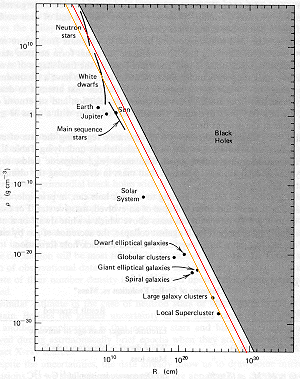
They only exist where either:
as Photons, they are in the Static/Induction Region; oras Vector Gravitons, they are in a region of SpaceTime where curvature is significant (i.e., a region not much smaller than R).
The SpaceTime regions where curvature is significant include:
( Compare angular momentum / electromagnetic relationships on many size scales. )
As to Cosmological Regions, in his book Mathematical Cosmology and Extragalactic Astronomy (Academic Press 1976) (pages 72-75), Segal says:
"... & / &T , the generator of ... [Conformal SpaceTime}temporal evolution [where & denotes partial derivative] ... appears in terms of Minkowski coordinates t,x,y,z [as] ...&/&T = &/&t + (1/4)( t^2 + X^2 + y^2 +z^2 ) &/&t + ( t/2 )( x &/&x + y &/&y + z &/&z ) ... the ... [Conformal SpaceTime] energy is ... positive, and exceeds (in all states) the special relativistic [Minkowski] energy ... the two time scales differ only by at most about 1 part in 10^19 in the course of a year (or less), and similarly for distance scales (scaled by the velocity of light); the difference is thus well beyond the limits of present experimental capabilities. ...".
As to Astrophysical Black Hole and Neutron Star Regions, Segal did not discuss them in his work, which was oriented primarily to cosmology (and some elementary particle theory), but not so much to structures as large as planets and stars and smaller than the universe as a whole. Obviously, Black Holes are regions in which SpaceTime Curvature is significant, but what other structures might also have significant curvature?
The following diagram, from Figure 1.1 of Black Holes, White Dwarfs, and Neutron Stars, by Shapiro and Teukolsky (Wiley-Interscience 1983),

shows that dense Neutron Stars may have significant curvature. In the diagram, I added the red line to show things that were 10% as large in radius as they need to be to form Black Holes of a given density, and the gold line to show things that were 1% as large in radius as they need to be to form Black Holes of a given density.
As to observations of phenomena that might be related to GraviPhoton phenomena in astrophysical structures, Tom Van Flandern has a web site at URL http://www.metaresearch.org in which he has a review of the book Seeing Red by Halton Arp. In the review, Van Flandern says that Arp's observations indicate that redshift is not just a Doppler distance effect, but is at least in part also related to "... an inverse function of the age of that matter ...".
What does Arp mean by "age of that matter"?
To quote from the review:
"... the O-stars in clusters within our galaxy are redshifted with respect to the B-stars by another 10 km/s or so -- something called the "K-effect" ...these apparently ejected quasars [have] redshifts ordered inversely with distance from their parent [and they] also tend to line up along the minor axis of the parent galaxy. ... the young-appearing objects with the highest redshifts are aligned on either side of eruptive objects, which implies the ejection of protogalaxies and the association of redshift with youth. Increasing distance from parent leads to brighter, lower redshift objects, so this is the direction of evolution with age. ...
Faraday rotation caused by traversing a magnetized plasma can be measured for quasars. So the amount of such rotation ought to be a distance indicator. But it was then discovered that quasars with redshifts of about 2 had only 1/3 as much Faraday rotation as quasars with redshifts of about 1, when they ought to have had twice as much rotation. By contrast, this is in accord with Arp's model because the redshift z = 2 quasars are intrinsically fainter, and therefore generally seen only at closer distances, than those with z = 1. ...".
How could "age" have any effect on redshift? Consider that the "young" objects with high redshift are closer to the time of formation, and that the process of formation is not just a gravitational collapse, but is also a dynamical ElectroMagnetic process involving very strong EM fields and related plasma effects that are not well understood by conventional physics. Such EM effects may involve longitudinal photons due to the very large scale of the Near Field in such dynamical astrophysical conditions, and so might produce redshift even though redshift is normally considered to be a "gravity-only" phenomenon.
Elementary Particle Phenomena could be involved, especially if you use the Compton Radius Vortex viewpoint of the D4-D5-E6-E7 physics model.
In one such obituary, Edward Nelson, who had Segal as advisor for his 1955 Chicago Ph.D., quoted Segal as saying (in a 1992 publication):
"... Universal space-time is ... locally conformal to Minkowski space and globally conformal to the Einstein universe E = R1 x S3 ... These developments ... suggest that the fundamental forces of Nature are conformally invariant, but that the state of the Universe breaks the symmetry down to the Einstein isometry group. This provides an alternative to the Higgs mechanism ...and otherwise has implications for particle physics, including
the elimination of ultraviolet divergencies in representative nonlinear quantum fields,
the formulation of a unified invariant interaction Lagrangian,
assignments of observed elementary particles to irreducible unitary positive-energy representations of the conformal group, and
the correlation of the S-matrix with the action in E of the generators of the infinite cyclic center of the simply-connected form of the conformal group. ... ".
Segal spent much time and effort on a quadratic cosmological redshift that he claimed was implicit in the physics of the Conformal Group. Segal's redshift was described by Bertram Kostant, who had Segal as advisor for his 1954 Chicago Ph.D., in another of the obituaries in the Notices of the AMS 46 (June/July 1999) 659-668.:
"... One particular nilpotent element, in the representation of SU(2,2) associated with solutions of Maxwell's equations, defines the standard operator to determine the frequencies of light waves.
[John Baez, who had Segal as advisor for his 1986 MIT Ph.D., says: "... That's the generator of Minkowski time translations. ... If you use the Minkowski Hamiltonian everywhere (there's one for each observer) you don't get the redshift. ... ".]
But Irving focused on another element with a nonnegative spectrum, an element that was elliptic and not nilpotent, but closely related ... This elliptic element has beautiful mathematical properties, like generating an invariant cone. ... This elliptic element is at the heart of Segal's cosmological theory.
[John Baez says: "... That's the generator of Einstein time translations. ... if you use the Einstein Hamiltonian everywhere you don't get the redshift. ... ".]
What he is saying is that it is the elliptic element that should be used to determine the energy of an electromangnetic wave, and not the nilpotent element.
[John Baez says: "... But if we do that *everywhere*, we simply get physics on the Einstein universe R x S^3 - no redshift. ... ".]
The redshift ... is accounted for by the difference between the elliptic and nilpotent element - negligible locally, but significant at great distances. ...".
[John Baez says: "... Aha: this is the tricky part. How is it "accounted for by the difference" between these elements, exactly? ... ".]
I. E. Segal, H. P. Jakobsen, B. Oersted, S. M. Paneitz, and B. Speh, in their article Covariant chronogeometry and extreme distances: Elementary particles (Proc. Nat. Acad. Sci. USA 78 (1981) 5261-5265, at page 5261), say: "... the energy of a photon in ...[ Conformal Unispace ]... splits Lorentz-covariantly into a local and delocalized part. The local part is represented by the conventional energy operator in ...[ Minkowski space-time ]... , which can be regarded as a submanifold of ...[ Conformal Unispace ]... ; the delocalized part drives, essentially as an interaction hamiltonian, a redshift in very good agreement with objective observations on galaxies and quasars. ...".
John Baez says: "... Segal used to say the dynamics of distant stars was governed by the Einstein Hamiltonian but we saw them from the Minkowski viewpoint. However, he never clarified how this should actually work. ...".
In my opinion, it might work like this:
Bertram Kostant said, in his Segal obituary article:
"... I have it from a highly reliable but unnamed source that there is a growing group of cosmologists who have come to believe that the correct understanding of the redshift is some sort of fusion of the Doppler effect and Irving's theory. So it is not impossible that Irving could turn out to be correct after all. ...".I asked Bertram Kostant about that quote, and he said that he did not name the source because the source requested anonymity because he (the source) wanted to avoid entanglement in the heated controversy that surrounds Segal's redshift ideas. I think that it is regrettable that interesting scientific ideas become so involved in unpleasant controversy that competent people become are intimidated from discussing such ideas. As to how and why Segal's ideas became controversial, Edward Nelson, in his Segal obituary article, said:"... Part of the reason lies in Segal's style of scientific exchange - at times is resembles that of Giordano Bruno (later burned at the stake), who very shortly after his arrival in Geneva issued a pamphlet on Twenty Errors Committed by Professor De la Faye in a Single Lesson. But part of the fault lies with cosmologists and particle physicists intent on defending turf. ...".
As to what "... sort of fusion of the Doppler effect and Irving's theory ..." might turn out to be true, Segal, in the General Conclusions section (pages 187-191) of his book Mathematical Cosmology and ExtraGalactic Astronomy (Academic 1976) says:
"... In principle, there is no difficulty in combining the chronometric redshift theory with some degree of expansion in accordance with a closed Friedmann model. As long as the rate of expansion is kept sufficiently low ... the basic features of the Friedmann theory and its correlation with cosmology, apart from the redshift itself, would be retained. Such a mixed theory cannot be excluded on a purely statistical basis, and would permit conventional ideas concerning the evolution and age of galaxies to persist in the combined theory without essential change. ...... it remains to be explored to what extent observational estimates of [such things as] the mass density of the universe ...[and]... energy production in galactic nuclei and quasars ... may be affected by employment of the chronometric ... excess of the unienergy ... over the special relativistic energy ... i.e., of the ... energy corresponding to the difference between the two times involved in the theory (... shown to be positive) ... The amount of energy involved is ... quite substantial ...".
In their tribute to Irving Ezra Segal (Notices of the AMS 48 (January 2001) 9-16), Auber Daigneault and Arturo Sangalli say:
"... It is not unthinkable that a rehabilitation of ... a cosmological constant ... /\ ... greater than zero ..., originally related to the radius r of S3 ...[of Segal's]... EU = R x S3 ... by the equation r = /\^(-(1/2)), could ... help Irving Ezra Segal's chronometric cosmology get the attention it deserves. ...".
I want to conclude this section of this web page with another quote from Edward Nelson's Segal obituary article
"... It is rare for a mathematician to produce a life work that at the time can be fully and confidently evaluated by no one, but the full impact of the work of Irving Ezra Segal will become known only to future generations."
and
with a comment that at least one person, Alexander Levichev, is working on Segal's ideas by conducting a seminar on Newton-Einstein-Segal, studying ways to apply Segal's ideas to Modelling Consciousness, and by putting on the web in ps format a paper entitled On Mathematical Foundations and Physical Applications of Chronometry ( which paper was published in the book "Semigroups in Algebra, Geometry and Analysis" ( ed. by Hofmann, Lawson, and Vinberg, Walter de Gruyter and Co, 1995 )).
In astro-ph/0112069, Mordehai Milgrom says:
"... In the early 1980s I proposed a modifed-dynamics ... based on the fact that typical accelerations in galactic systems are many orders of magnitude smaller than those encountered in the solar system. ... This modified dynamics, MOND, introduces a constant with the dimensions of an acceleration, a_0, and posits that standard Newtonian dynamics is a good approximation only for accelerations that are much larger than a_0. ... the basic point of MOND, from which follow most of the main predictions, can be simply put as follows: a test particle at a distance r from a large mass M is subject to the acceleration a given by
when a << a_0, instead of the standard expression a = M G r^(-2) , which holds when a >> a_0. ... The value of the acceleration constant a_0 that fits all the data discussed ...[ in the paper ]... is about 10^(-8) cm s^(-2) ...
... One immediate result ... is that at a large radius around a mass M, the orbital speed on a circular orbit becomes independent of radius. This indeed was a guiding principle in the construction of MOND, which took asymptotic flatness of galaxy rotation curves as an axiom ... When we count the mass of baryonic matter in such systems - in stars, neutral and high-T gas, etc.- the total sum does not provide enough gravity to explain the observed accelerations in such systems within standard physics. If we adhere to standard dynamics, the need for dark matter is the only solution we can conceive. It is, however, possible that the laws of dynamics, proven in the laboratory and the solar system, cannot be simply applied in the realm of the galaxies. ... Regarding galactic systems other than galaxies, the comparison of the systematics of the observed mass discrepancy with the expectations from MOND are shown in Figure 2
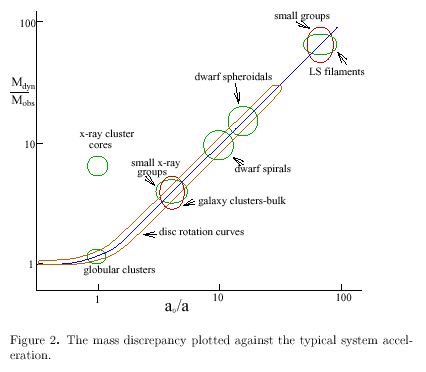
in Milgrom (1998) [ astro-ph/9810302 , which says:
"... MOND is not a modification at large distances, but at low accelerations - which for a given mass are attained at large distances ... there is no correlation of the discrepancy with system size. ...... in particular ... the small dwarf spheroidals and LSB discs show large discrepancies, while the large galaxy clusters evince only moderate discrepancies...." ]. ... based on analyzes referenced there.
The agreement is uniform, with one exception: The cores of rich x-ray clusters of galaxies show a considerable mass discrepancy, while, according to MOND there shouldn't be any, because the accelerations there are only of the order of a_0, and not much smaller. ( Application of MOND to the clusters at large, say within a few megaparsecs of the center, does predict correctly the mass discrepancy. ) The resolution, by MOND, will have to be that these cores harbor large quantities of still undetected baryonic matter, perhaps in the form of dim stars, perhaps as warm gas. The environment, and history, of these cores is so unlike others that this would not be surprising. ...
... in interpreting data we equate observed accelerations with the gravitational field ... We can exemplify this point by considering the claimed anomaly in the motions of the Pioneer 10 and 11 spacecraft. Analysis of their motion have shown an unexplained effect ...[ see Anderson & al 2001, Study of the anomalous acceleration of Pioneer 10 and 11, gr-qc/0104064 ]... that can be interpreted as being due to an unexplained constant acceleration towards the sun of about 7 x 10^(-8) cm s^(-2) , of the order of a_0. ... MOND could naturally explain such an anomalous acceleration ... It may well be that the modification enters the Pioneers motion, which corresponds to unbound, hyperbolic motions, and the motion of bound, and quasi-circular trajectories in a different way. ...
... It is worth pointing out that in such a modified-gravity theory, the deep-MOND limit ... the deep-MOND regime ( a << a_0 ) ... corresponds to a theory that is conformally invariant, as discussed in Milgrom (1997) [ gr-qc/9705003 which says:
"... The Poisson equation describes many physical problems in linear media such as electrostatics, magnetostatics, steady-state diffusion and other potential flows in the presence of sources and sinks, and, of course, Newtonian gravity. It can be generalized ... to describe, for example, non-linear media with a response coefficient (dielectric constant, permeability, diffusion coefficient, etc.) that is a function of the field strength. ... For example, ... as a modification of Newtonian gravity to replace the dark-matter hypothesis for galactic systems ... In the modified dynamics discussed as an alternative to dark matter, phenomenology requires just this ... conformally invariant (CI) ... Our results here apply then in the large-distance limit of this theory. ...". ]. ...
... this asymptotic rotational speed depends only on the total mass M via V^4 = M G a_0 . This, according to MOND, is the fact underlying the observed Tully-Fisher-type relations, by which the typical (mean) rotational velocity, V , in a disc galaxy is strongly correlated with the total luminosity of the galaxy, L, in a relation of the form L ...[ proportional to ]... V^alpha . The power alpha is around 3-4, and depends on the wavelength band at which L is measured. The close agreement between this TF [ Tully-Fisher-type ] relation and the prediction of MOND is encouraging; but, to test MOND more precisely on this count, one would have to bridge properly the mass-asymptotic-velocity MOND relation with the commonly presented luminosity-bulk-velocity TF relation. One should use the luminosity in a band where it is a good representative of the stellar mass, take into account not only the stellar mass, as represented by the luminosity, but also the contribution of gas to the mass, and use the asymptotic velocity, as opposed to other measures of the rotational velocity. It has emerged recently ... that if one does all this one indeed obtains a tight and accurate relation of the form predicted by MOND. ...".
In his book Mathematical Cosmology and Extragalactic Astronomy (Academic Press 1976) (page 68), Segal says: "... We use the term unispace (short for universal covering space) for the universal space ... unispace is conformally an infinite-sheeted covering of Minkowski space augmented by a light cone at infinity. Similarly, unitime refers to the natural time T in this space. ...".
In the D4-D5-E6-E7-E8 VoDou Physics model, our 4-dimensional Physical SpaceTime Universe begins as a relatively small spatial volume that is entirely high-energy unispace, in which all 15 generators of Conformal Spin(2,4) Unispace, including the 4 Conformal GraviPhoton generators, are effective.

After some expansion, some regions of our Universe become Gravitationally Bound Domains (such as, for example, Galaxies) in which the 4 Conformal GraviPhoton generators are frozen out, forming domains within our Universe like IceBergs in an Ocean of Water.
Note that Gravitationally Bound Domains are defined by their gravitational accelerations, not by their size - there is no correlation with system size.
The process of formation of Gravitationally Bound Domains releases (like latent heat of fusion when Ice freezes from Water) the excess of the Conformal Unienergy of Unispace over the Poincare Energy of Minkowski space.
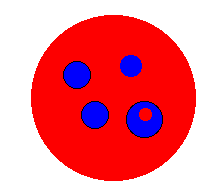
Note that, within the Gravitationally Bound Domains there can exist Islands of Unispace in which all 15 generators of Conformal Spin(2,4) remain effective (such as, for example, Protostar Clouds of Dust and Gas - like Puddles of Water on an IceBerg floating in an Ocean of Water -
When a Protostar Clouds of Dust and Gas condense to form the Gravitationally Bound Domain of a Star and its Planets, the process releases (like latent heat of fusion when Ice freezes from Water) the excess of the Conformal Unienergy of Unispace over the Poincare Energy of Minkowski space).
During and after more expansion of our Universe as a whole, the Gravitationally Bound Domains do not expand within themselves, but are carried apart from each other as in the familiar example of inflating a Balloon with Coins glued to its surface.
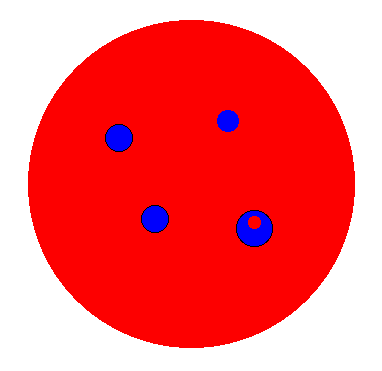
Since our laboratories on our Earth are Gravitationally Bound Domains, our conventional experiments on Earth only see the Poincare Energy of Minkowski space.
However:
Since the Pioneer spacecraft are not bound to our Solar System,
In their Study of the anomalous acceleration of Pioneer 10 and 11, gr-qc/0104064, John D. Anderson, Philip A. Laing, Eunice L. Lau, Anthony S. Liu, Michael Martin Nieto, and Slava G. Turyshev say: "... The latest successful precession maneuver to point ...[Pioneer 10]... to Earth was accomplished on 11 February 2000, when Pioneer 10 was at a distance from the Sun of 75 AU. [The distance from the Earth was [about] 76 AU with a corresponding round-trip light time of about 21 hour.] ... The next attempt at a maneuver, on 8 July 2000, was unsuccessful ... conditions will again be favorable for an attempt around July, 2001. ... At a now nearly constant velocity relative to the Sun of 12.24 km/s, Pioneer 10 will continue its motion into interstellar space, heading generally for the red star Aldebaran ... about 68 light years away ... it should take Pioneer 10 over 2 million years to reach its neighborhood....
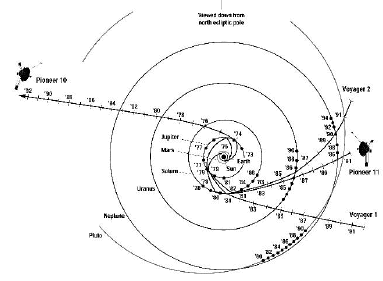
Ecliptic pole view of Pioneer 10, Pioneer 11, and Voyager trajectories. Digital artwork by T. Esposito. NASA ARC Image # AC97-0036-3.
... on 1 October 1990 ... Pioneer 11 ... was [about] 30 AU away from the Sun ... The last communication from Pioneer 11 was received in November 1995, when the spacecraft was at distance of [about] 40 AU from the Sun. ... Pioneer 11 should pass close to the nearest star in the constellation Aquila in about 4 million years ...
... Calculations of the motion of a spacecraft are made on the basis of the range time-delay and/or the Doppler shift in the signals. This type of data was used to determine the positions, the velocities, and the magnitudes of the orientation maneuvers for the Pioneer, Galileo, and Ulysses spacecraft considered in this study. ... The Pioneer spacecraft only have two- and three-way S-band Doppler. ... analyses of radio Doppler ... data ... indicated that an apparent anomalous acceleration is acting on Pioneer 10 and 11 ... The data implied an anomalous, constant acceleration with a magnitude a_P = 8 x 10^(-8) cm / s^2 , directed towards the Sun ...
... The anomalous acceleration is too large to have gone undetected in planetary orbits, particularly for Earth and Mars. ... For Earth and Mars, delta_r is about -21 km and -76 km. However, the Viking data determines the difference between the Mars and Earth orbital radii to about a 100 m accuracy, and their sum to an accuracy of about 150 m. The Pioneer effect is not seen. Further, a perturbation in r produces a perturbation to the orbital angular velocity ... The determination of the synodic angular velocity ... is accurate to 7 parts in 10^11 , or to about 5 ms accuracy in synodic period. The only parameter that could possibly mask the spacecraft-determined a_R is ( G M_sun ). But a large error here would cause inconsistencies with the overall planetary ephemeris ... Also, there would be a problem with the advance of the perihelion of Icarus ... We conclude that the Viking ranging data limit any unmodeled radial acceleration acting on Earth and Mars to no more than 0.1 x 10^(-8) cm / s^2 . ... the size of the anomalous acceleration is of the order c H, where H is the Hubble constant ...
... The Aerospace Corporation's Compact High Accuracy Satellite Motion Program (CHASMP) ... analysis of Pioneer 10 data ... showed an unmodeled acceleration in a direction along the radial toward the Sun ... The value is ( 8.65 +/- 0.03 ) x 10^(-8) cm / s^2 ... agreeing with JPL's result ...
... Without using the apparent acceleration, CHASMP shows a steady frequency drift of about -6 x 10^(-9) Hz / s, or 1.5 Hz over 8 years (one-way only). ...
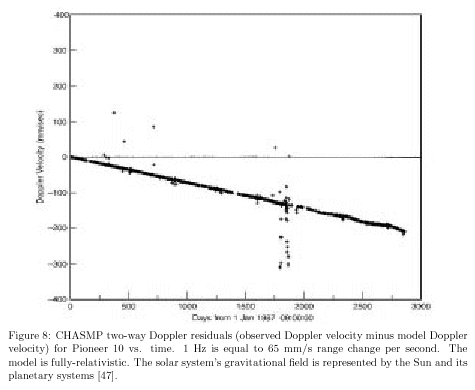
... This equates to a clock acceleration, -a_t, of -2.8 x 10^(-18) s / s^2 . The identity with the apparent Pioneer acceleration is a_P = a_t c. ...
... Having noted the relationships
and that of ...
if H = 82 km / s / Mpc ...
we were motivated to try to think of any ... "time" distortions that might ... fit the CHASMP Pioneer results ... In other words ...
... In particular we considered ... Quadratic Time Augmentation. This model adds a quadratic-in-time augmentation to the TAI-ET ( International Atomic Time - Ephemeris Time ) time transformation, as follows
The model fits Doppler fairly well ...
... There was one [other] model of the ...[time acceleration]... type that was especially fascinating. This model adds a quadratic in time term to the light time as seen by the DSN station:
-> delta_TAI + (1/2) a_quad (TAI_received^2 - TAI_sent^2 )
It mimics a line of sight acceleration of the spacecraft, and could be thought of as an expanding space model. Note that a_quad affects only the data. This is in contrast to the a_t ... that affects both the data and the trajectory. ... This model fit both Doppler and range very well. Pioneers 10 and 11 ... the numerical relationship between the Hubble constant and a_P ... remains an interesting conjecture. ...".
In his book Mathematical Cosmology and Extragalactic Astronomy (Academic Press 1976) (pages 61-62 and 72), Segal says:
"... Temporal evolution in ... Minkowski space ... is
... unispace temporal evolution ... is ...
...".
Therefore,
Rosales and Sanchez-Gomez say, at gr-qc/9810085 :
"... the recently reported anomalous acceleration acting on the Pioneers spacecrafts should be a consequence of the existence of some local curvature in light geodesics when using the coordinate speed of light in an expanding spacetime. This suggests that the Pioneer effect is nothing else but the detection of cosmological expansion in the solar system. ... the ... problem of the detected misfit between the calculated and the measured position in the spacecrafts ... this quantity differs from the expected ... just in a systematic "bias" consisting on an effective residual acceleration directed toward the center of coordinates; its constant value is ... H c ... This is the acceleration observed in Pioneer 10/11 spacecrafts. ... a periodic orbit does not experience the systematic bias but only a very small correction ... which is not detectable ... in the old Foucault pendulum experiment ... the motion of the pendulum experiences the effect of the Earth based reference system being not an inertial frame relatively to the "distant stars". ... Pioneer effect is a kind of a new cosmological Foucault experiment, the solar system based coordinates, being not the true inertial frame with respect to the expansion of the universe, mimics the role that the rotating Earth plays in Foucault's experiment ...".
The Rosales and Sanchez-Gomez idea of a 2-phase system in which objects bound to the solar system (in a "periodic orbit") are in one phase (non-expanding pennies-on-a-balloon) while unbound (escape velocity) objects are in another phase (expanding balloon) that "feels" expansion of our universe is very similar to my view of such things as described on this page. The Rosales and Sanchez-Gomez paper very nicely unites:
My view, which is consistent with that of Rosales and Sanchez-Gomez, can be summarized as a 2-phase model based on Segal's work which has two phases with different metrics:
If you look closely at the difference between the metrics in those two regions, you see that the full conformal dark energy region gives an "extra acceleration" that acts as a "quadratic in time term" that has been considered as an explanation of the Pioneer effect by John D. Anderson, Philip A. Laing, Eunice L. Lau, Anthony S. Liu, Michael Martin Nieto, and Slava G. Turyshev in their paper at gr-qc/0104064 .
Jack Sarfatti has a 2-phase dark energy / dark matter model that can give a similar anomalous acceleration in regions where c^2 /\ dark energy / dark matter is effectively present. If there is a phase transition (around Uranus at 20 AU) whereby ordinary matter dominates inside that distance from the sun and exotic dark energy / dark matter appears at greater distances, then Jack's model could also explain the Pioneer anomaly and it may be that Jack's model with ordinary and exotic phases and my model with deSitter/Poincare and Conformal phases may be two ways of looking at the same thing. As to what might be the physical mechanism of the phase transition, Jack says
"... Rest masses of [ordinary matter] particles ... require the smooth non-random Higgs Ocean ... which soaks up the choppy random troublesome zero point energy ...".
In other words in a region in which ordinary matter is dominant, such as the Sun and our solar system, the mass-giving action of the Higgs mechanism "soaks up" the Dark Energy zero point conformal degrees of freedom that are dominant in low-ordinary mass regions of our universe (which are roughly the intergalactic voids that occupy most of the volume of our universe). That physical interpretation is consistent with my view.
It may be that the observation of the Pioneer phase transition at Uranus from ordinary to anomalous acceleration is an experimental result that gives us a first look at dark energy / dark matter phenomena that could lead to energy sources that could be even more important than the nuclear energy discovered during the past century.
In gr-qc/0104064, Anderson et al say:
"... Beginning in 1980 ... at a distance of 20 astronomical units (AU) from the Sun ... we found that the largest systematic error in the acceleration residuals was a constant bias, aP, directed toward the Sun. Such anomalous data have been continuously received ever since. ...",
so that the transition from inner solar system Minkowski acceleration to outer Segal Conformal acceleration occurs at about 20 AU, which is about the radius of the orbit of Uranus. That phase transition may account for the unique rotational axis of Uranus,
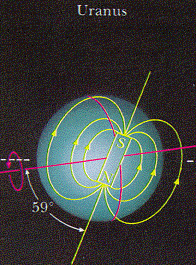
which lies almost in its orbital plane.
The most stable state of Uranus may be with its rotational axis pointed toward the Sun, so that the Solar hemisphere would be entirely in the inner solar system Minkowski acceleration phase and the anti-Solar hemisphere would be in entirely in the outer Segal Conformal acceleration phase.
Then the rotation of Uranus would not take any material from one phase to the other, and there would be no drag on the rotation due to material going from phase to phase.
Of course, as Uranus orbits the Sun, it will only be in that most stable configuration twice in each orbit, but an orbit in the ecliptic containing that most stable configuration twice (such as its present orbit) would be in the set of the most stable ground states, although such an effect would be very small now.
However, such an effect may have been been more significant on the large gas/dust cloud that was condensing into Uranus and therefore it may have caused Uranus to form initially with its rotational axis pointed toward the Sun.
In the pre-Uranus gas/dust cloud, any component of rotation that carried material from one phase to another would be suppressed by the drag of undergoing phase transition, so that, after Uranus condensed out of the gas/dust cloud, the only remaining component of Uranus rotation would be on an axis pointing close to the Sun, which is what we now observe.
In the pre-Uranus gas/dust cloud, any component of rotation that carried material from one phase to another would be suppressed by the drag of undergoing phase transition, so that, after Uranus condensed out of the gas/dust cloud, the only remaining component of Uranus rotation would be on an axis pointing close to the Sun, which is what we now observe.

Much of the perpendicular (to Uranus orbital plane) angular momentum from the original gas/dust cloud may have been transferred (via particles "bouncing" off the phase boundary) to the clouds forming Saturn (inside the phase boundary) or Neptune (outside the phase boundary, thus accounting for the substantial (relative to Jupiter) deviation of their rotation axes from exact perpendicularity (see above image from Universe, 4th ed, by William Kaufmann, Freeman 1994).
According to Utilizing Minor Planets to Assess the Gravitational Field in the Outer Solar System, astro-ph/0504367, by Gary L. Page, David S. Dixon, and John F. Wallin:
"... the great distances of the outer planets from the Sun and the nearly circular orbits of Uranus and Neptune makes it very difficult to use them to detect the Pioneer Effect. ... The ratio of the Pioneer acceleration to that produced by the Sun at a distance equal to the semimajor axis of the planets is 0.005, 0.013, and 0.023 percent for Uranus, Neptune, and Pluto, respectively. ... Uranus' period shortens by 5.8 days and Neptune's by 24.1, while Pluto's period drops by 79.7 days. ... an equivalent change in aphelion distance of 3.8 x 10^10, 1.2 x 10^11, and 4.3 x 10^11 cm for Uranus, Neptune, and Pluto. In the first two cases, this is less than the accepted uncertainty in range of 2 x 10^6 km [ or 2 x 10^11 cm ] (Seidelmann 1992). ... Pluto['s] ... orbit is even less well-determined ... than the other outer planets. ... .... [C]omets ... suffer ... from outgassing ... [ and their nuclei are hard to locate precisely ] ...".
According to a google cache of an Independent UK 23 September 2002 article by Marcus Chown:
"... The Pioneers are "spin-stabilised", making them a particularly simple platform to understand. Later probes ... such as the Voyagers and the Cassini probe ... were stabilised about three axes by intermittent rocket boosts. The unpredictable accelerations caused by these are at least 10 times bigger than a small effect like the Pioneer acceleration, so they completely cloak it. ...".
To do that, we would have to construct an Island of Unispace - a process would require putting into the domain an amount of energy at least equal to the excess of the Conformal Unienergy of Unispace for the domain over the Poincare Energy of Minkowski space for the domain - like adding the latent heat of fusion when Ice melts to form Water).
In his book Mathematical Cosmology and Extragalactic Astronomy (Academic Press 1976) (page190-191), Segal says:
"... in the very natural form of ...Weyl's conformally oriented theory ... presented by Veblen ... there intervene both a scalar and a vector field, such as are provided locally by the chronometric theory in the R -> infinity limit. ... the mere modification of a Minkowski metric by the introduction of these two fields ... is sufficient to imply all the observational consequences of general relativity (cf., e.g., Hawking and Ellis, 1973). ...... The mechanism of energy production in galactic nuclei and quasars ... consists basically of the transformation of the excess of the unienergy (1/i) (&/&T ) over the special relativistic energy (1/i) (&/&t), i.e., of the new form of energy corresponding to the difference between the two times involved in the theory (... shown to be positive) into elementary particle processes. ...
... the fundamental local dynamical variables of the chronometric theory, energy, momenta, etc., differ from those of special relativistic field theory by terms of order 1/R, or less, where R is the radius of the universe in conventional laboratory units. ... the subgroup ... O(2,3) ... facilitates mass splitting ... The role of ... the D'Alembertian ... [] would be taken over by the Casimir operator for O(2,3), which differs essentially from [] ...[ of the Conformal Group Spin(2,4) = SU(2,2) ]... only by terms of order 1/R. ...".
and at pages 89-90:
"... The suitably scaled 15 linearly independent generators Lij of symmetries of unispace ... differ from the 11 generators of the group of global conformal transformations in Minkowski space by terms of order 1/R^2, as R -> infinity. ...... It might appear anomalous that 15 vector fields converge to 11 vector fields. What happens is that two ordered sets, each consisting of four of the Lij, converge to the same conformal fields in Minkowski space. ...
... define the (physically scaled) uni-energy-momentum vector to have the form
( - i (1/R) L(-1,0) , - i (1/R) L(-1,1) , i (1/R) L(-1,2) , i (1/R) L(-1,3) ) ... (1/R) L(-1,j) and (1/R) L(j,4) both differ from ej &/&x'j by O(1/R^2), and agree in the limit R -> infinity with the conventional energy-momentum component ej &/&x'j . The differences L(-1,j) - L(j,4) thus are locally approximate absolute constants of the motion. As such they are locally approximately representable by a slowly-varying vector field, which physically would appear most naturally as potentially related to gravitational phenomena as in the Weyl-Veblen theory, but possibly related also to microscopic processes as internal quantum numbers. ...".
For the design of our Unconventional Laboratory Experiment here on Earth, R would be the size of the domain of the experiment, so that 1/R ( as well as 1/R^2 ) would be about 1/R = 1/1 = 1, and the excess of the Conformal Unienergy of Unispace for the domain over the Poincare Energy of Minkowski space for the domain would be about the total Poincare Energy of the total domain of the experiment, so that:
Effectively, that means levitating the Unconventional Laboratory Experiment so that it is no longer part of a Gravitationally Bound Domain. It must be freed, not only from being Gravitationally Bound to Earth, but also from being Gravitationally Bound to the Sun and to the Milky Way Galaxy.
A useful configuration might be 4 Rodin coils arranged in the geometry of a Fuller Vector Eqilibrium Cuboctahedron.
Each Rodin coil would have the geometry of a Hopf fibration of a 3-sphere S3 by Clifford circles.
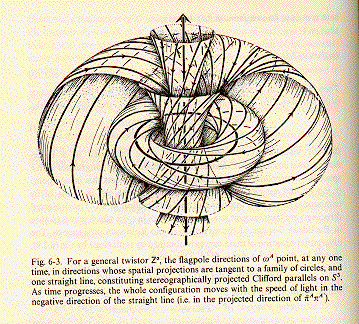
There should be 4 coils, one for each of the 4 physical dimensions of SpaceTime, and they should be configured as 4 axes that are 3-dim projections of the 4-dim coordinate axes of the 4-dim 24-cell, i.e., as 4 axes of Fuller's Vector Equilibrium, the cuboctahedron,
The 4 Rodin Coil Clifford-Hopf Tori are indicated by the cyan, magenta, yellow, and green hexagonal "equators" of a cuboctahedron
which configuration is a 3-dimensional projection of the 4-dimensional 24-cell
Each of the 12 vertices of the cuboctahedron corresponds to 2 of the 24 vertices of the 24-cell, which 24 vertices are the vertices of a green cuboctahedron, a red octahedron, and a blue octahedron.
Here is a different perspective illustration, patterned after Fig. 172 of Geometry and the Imagination (Anschauliche Geometrie) by David Hilbert and S. Cohn-Vossen (Chelsea 1952), with 12 green vertices of a central cuboctahedron, 6 red vertices of an inner octahedron, and 6 blue vertices of an outer octahedron:
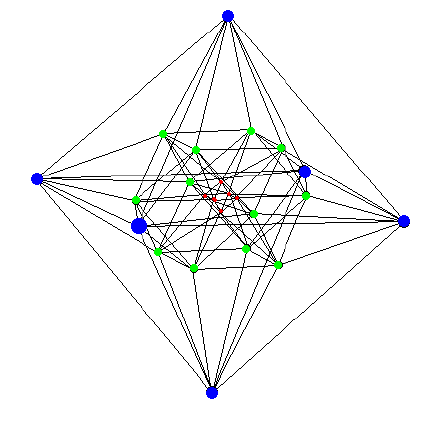
The 4 Rodin Coil Clifford-Hopf Tori of the cyan, magenta, yellow, and green hexagonal "equators" of a cuboctahedron appear on the 24-cell as four ( cyan, magenta, yellow, and green ) hexagonal rings:
Since the 24-cell is self-dual, the 4 hexagonal rings can also be seen as 4 rings of 6 octahedral faces.
Three such rings of octahedra are of the same type as the one illustrated here
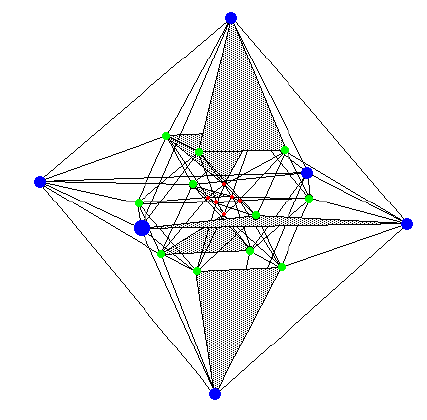
where the common triangular faces of the 6 octahedra in the ring are shaded.
The fourth ring, corresponding to the green ring of 6 octahedra, all of which are in the central cuboctahedron, is of the type similarly illustrated here
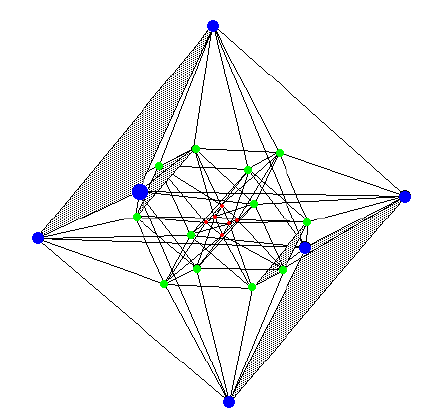
The three similar rings can be thought of as space-like, while the distinct fourth ring can be thought of as timelike.
Note that the 6th octahderon of the distinct ring consists of the exterior of the outer octahedron, going all the way to infinity.
Note also that if you were to try to construct a Rodin coil, you would have to be careful that the loops are oriented correctly with respect to each other as shown in the 24-cell illustrations, and that the cuboctahedron projection illustration obscures some of that orientation information.
Also, you should realize that flows through the Rodin coil would be described by the dual 24-cell to the 24-cell used in construction of the windings of the Rodin coil, and
As noted by Johan E. Mebius, "... The 96 edges of the 24-cell make up 16 regular hexagons. ...". The Clifford-Hopf configuration shown above uses 4x6 = 24 of the 96 edges, and 4 of the 16 regular hexagons. The remaining 72 edges, or 12 hexagons, fall into three more distinct Clifford-Hopf configurations of 24 edges, or 4 hexagons, each.
You can think of the four Clifford-Hopf configurations as corresponding to four possible orientations in 4-dimensional spacetime of Clifford-Hopf fibrations of the 3-sphere S3.
The Clifford-Hopf configurations are a finite version of the Hopf fibration of S3, as mentioned by Coxeter (in his book Regular Complex Polytopes, 2nd ed, Cambridge 1991, pp. 53 and 204), where Coxeter says:
The 24-cell and cuboctahedral Clifford-Hopf geometry is used in the conformal graviphoton physics of the 4-dimensional HyperDiamond Feynman Checkerboard Lattice of the D4-D5-E6-E7-E8 VoDou Physics model.
Rodin coil experiments such as those described above may be useful in building StarGate Ring Ships and in construction of star-gate worm-holes, whose stability might be interpretable in terms of ghosts, and in the utilization on Earth of /\ > 0 Zero-Point Energy.
Tony Smith's Home Page ......